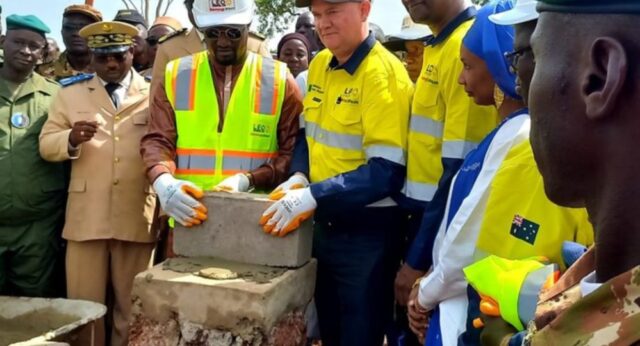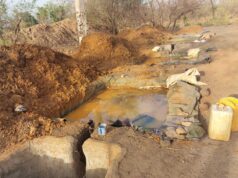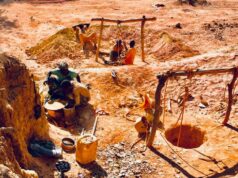In 2024, Leo-Lithium company will begin producing lithium in Mali, at Galamina in the Bougouni region. A first experience for the country. Experts are concerned about the negative impact on the environment.
The 15 industrial gold mines in operation contributed more than 70% of the country’s exports in 2022. The mining sector contributes 20.73% of government revenue and 9.74% of gross domestic product (GDP), according to data from the National Geology and Mining Directorate (DNGM). The sector’s contribution to job creation is estimated at 0.8%. The mining sector plays an important role in the Malian economy, according to these statistics. The sector is still dominated by gold.
Since 2004, Mali has adopted a policy of diversifying its mineral resources, according to Professor Dialla Konaté, Mineral Engineer and Director of Mineral Resources at Mali Minérales Ressources. As part of this diversification process, the country now has two lithium projects that are well advanced. The Galamina project (Firefinch Ltd), currently under construction, is due to start production in the first half of 2024, while the Bougouni project (Minéraux Kodal) in the village of N’ganala is at a very advanced stage of exploration.
The Galamina lithium mining licence covers an area of 100 km², and will run for 21 years. According to Professor Dialla Konaté, the company will transport the semi-finished product, spodumene concentrate, by road to the ports of Abidjan and Dakar.
Lithium, a transition mineral with a lot at stake
Lithium is a mineral that can be obtained from two main sources, salt marshes and the rock form found globally in pegmatites. “This rock form is the second form of lithium found in nature and can be mined using the usual mining methods, depending on the nature of the finished product or commodity that you want to sell to downstream buyers,” explains Professor Dialla Konaté.
Lithium, a strategic mineral that has been described as a clean ore, is vital for the production of clean energy. It helps to ensure the energy transition. With the global trend to combat climate change, there is a scramble for transition minerals such as lithium. The aim is to move away from the more polluting fossil fuels (oil, gas, coal, etc.) towards clean energy.
This situation is increasing global demand for this resource. A number of African countries, including Mali, are rich in it. Mali has a large lithium reserve. The Galamina project “is one of the largest undeveloped hard rock lithium deposits in the world”, according to Leo Lithium company (more on the Goulamina project – Leo Lithium Limited). The size of the resources, 211 million tonnes, makes Goulamina the fourth-largest spodumene deposit in the world. Its exploitation will make Mali the 1ᵉʳ largest West African producer of lithium.
Legal safeguards
However, lithium mining is a new exercise that Mali has never attempted in the past, according to Cheick G. Fanta Mady Keïta, Mali’s National Director of Geology and Mining (directeur national de la géologie et des mines du Mali – DNGM). Concerns remain because Mali has no previous experience of exploiting this type of mineral.
“To date, neither the Malian communities, nor the administration, nor civil society can boast any proven experience to premeditate the potential economic spin-offs and harmful environmental impacts of the exploitation of this mineral”, he declares. But even if there are doubts about the impact of mining, Mali’s legal framework provides safeguards.
The Galamina lithium mine is operated by a joint venture between China’s Ganfeng Lithium, Australia’s Leo Lithium and the Malian government. The environmental licence and the operating licence were granted in 2019 (PowerPoint presentation) on the basis of the 2012 Mining Code, the Code in force at the time the licence was granted.
The Code sets out the protection of the environment and cultural heritage in Article 142: “Any holder of a mining title or authorisation to open and operate a quarry is required to comply with the legislative and regulatory provisions relating to the environment in force in Mali”. What are these provisions?
The DNGM points out that the 2012 Malian Mining Code requires an Environmental and Social Impact Assessment (ESIA) and an environmental permit as part of the application file for any mining permit. It was the National Sanitation and Pollution and Nuisance Control Department (Direction Nationale de l’Assainissement et du Contrôle des Pollutions et des Nuisances – DNACPN) that issued the environmental permit in March 2016 on the basis of the environmental and social impact study drawn up in 2018.
According to Balla SISSOKO, head of the environmental and social assessment division at DNACPN, the ESIA is carried out in three stages, including approval of the terms of reference (field work), public consultation with communities and validation of the report by the ESIA technical committee. The ESIA report identifies the negative effects of the development project and recommends measures to minimise or compensate for them.
Another provision of the Mining Code relating to environmental protection is the obligation for mining companies to periodically update their ESIA. The same Code creates a fund for the rehabilitation of sites after closure. This fund is housed in a local bank and paid into by the company according to the amounts determined in the ESIA. This money is intended to rehabilitate the site when the mine closes.
Civil society remains sceptical
Despite the existence of these legal guarantees, civil society experts remain sceptical. This is the case of Nouhoum DIAKITE, Coordinator of the Malian coalition Publish What You Pay (PWYP-Mali), a civil society organisation working for good governance in the extractive industries.
For Nouhoum DIAKITE, the exploitation of this energy transition mineral, thanks to its specificity, is very important, because it will produce less polluting energy. “But the type of mining that will be carried out in Mali will require the use of a lot of water. PWYP-Mali is concerned about protecting the environment at this exhibition,” says Mr DIAKITE.
This concern was confirmed by Balla Sissoko of the DNACPN, who explained that “mining one tonne of lithium requires around 2,000 litres of water”. This mining will therefore have an impact on the fauna and flora, but also on the local population’s drinking water supply, as the mining company’s high demand will dry up the water tables.
According to Nouhoum DIAKITE, PWYP Mali, who has identified around 13 villages that will be affected by mining, “the use of explosives by the company for mining could create noise problems, even though sirens will warn the population before the explosions”. Despite these concerns, the head of the environmental and social assessment division at the DNACPN is reassuring. In his view, Leo-lithium company has complied with all the ESIA procedures. As far as follow-up is concerned, he believes that public officials must play their role as mining police.
The environmental and social impact study was presented by Léo-Lithium experts to the surrounding villages during information sessions. These sessions focused on the possible environmental consequences of mining, water management, the possibility of water contamination from a certain distance, etc., according to local residents contacted by telephone.
Famoussadjè Samaké, a resident of Galamina, confirms that these sessions are taking place: “Leo-lithium has informed us that lithium is being mined in our village with the agreement of the Malian government. They informed us that this exploitation will cause some effects before reassuring us that all measures will be taken to deal with this”.
To remedy the water problem, for example, Leo-Lithium promised to provide the people of the surrounding villages with fountains in certain places. But Famoussadjè Samaké complains that some of the promises have not been kept: “Farmers’ land within the operating perimeter has been compensated in cash. The communities have made other demands, including the employment of young people from the village as labourers on the sites, the development of market garden plots for women, access to drinking water through the drilling of boreholes, and the construction of basic social infrastructure (schools, health centres, etc.). However, none of these grievances has been honoured”.
For all these reasons, on 24 March 2023, Abdoul Wahab Diakité, President of the PWYP-Mali Coalition, called on the Malian government at a press conference to publish the Galamina mine transfer contract and its annexes in full, to make the conclusions of the Environmental and Social Impact Assessment available to the communities affected in the villages of Bougouni and Galamina and to civil society, and to hold regular information sessions for the population and civil society on the future challenges of this operation in Mali. In his view, the future challenges of lithium mining in Mali are little known to the general public.
Investigation carried out by Zéïnabou FOFANA with the support of the Norbert Zongo Unit for Investigative Journalism in West Africa (CENOZO).










